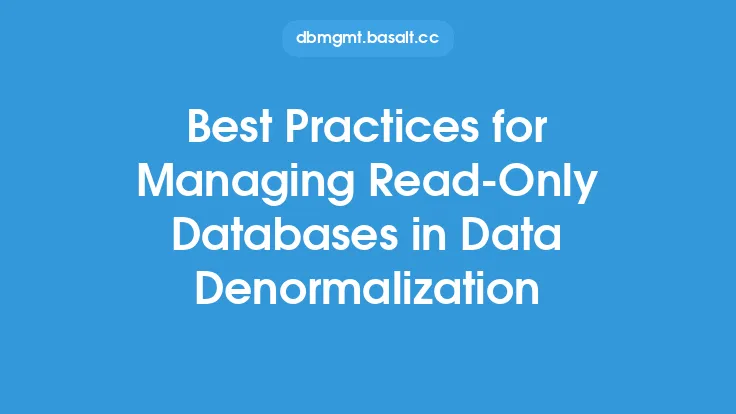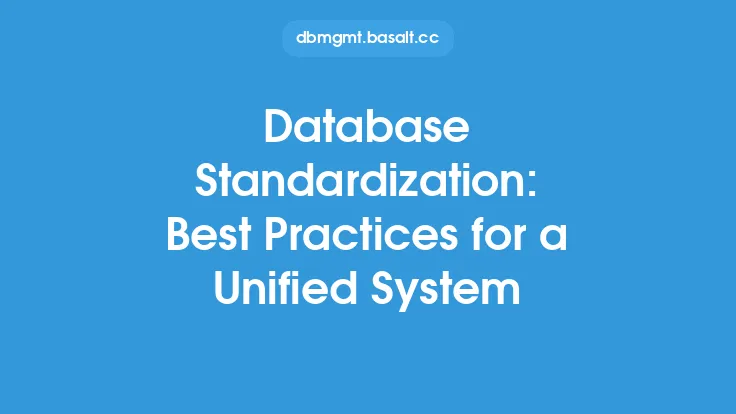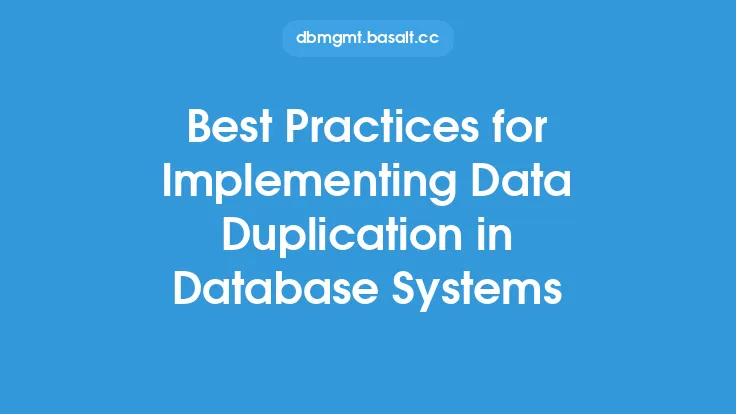When designing a database, one of the key considerations is how to structure the data to achieve optimal performance, scalability, and maintainability. Normalization is a widely accepted principle of database design that involves organizing data into tables to minimize data redundancy and improve data integrity. However, in certain situations, denormalization can be a useful technique to improve database performance by reducing the number of joins required to retrieve data. Denormalization involves intentionally deviating from the principles of normalization to achieve specific performance or scalability goals.
Introduction to Denormalization
Denormalization is a database design technique that involves storing data in a way that is not fully normalized. This means that some data may be redundant or duplicated, which can improve query performance by reducing the number of joins required to retrieve data. Denormalization can be used to improve the performance of queries that require data from multiple tables, by storing the required data in a single table. However, denormalization can also lead to data inconsistencies and make it more difficult to maintain data integrity.
Benefits of Denormalization
Denormalization can provide several benefits, including improved query performance, reduced join operations, and improved data retrieval. By storing data in a denormalized form, queries can be executed more quickly, as the database does not need to perform as many joins to retrieve the required data. Denormalization can also improve data retrieval by providing a more straightforward way to access data, as the required data is stored in a single table. Additionally, denormalization can reduce the complexity of queries, making it easier to maintain and optimize the database.
Types of Denormalization
There are several types of denormalization, including pre-aggregation, pre-joining, and data duplication. Pre-aggregation involves storing aggregated data, such as sums or averages, in a separate table to improve query performance. Pre-joining involves storing data from multiple tables in a single table to reduce the number of joins required to retrieve data. Data duplication involves storing duplicate data in multiple tables to improve query performance. Each type of denormalization has its own advantages and disadvantages, and the choice of which type to use depends on the specific requirements of the database.
Denormalization Techniques
Several denormalization techniques can be used to improve database performance, including materialized views, summary tables, and indexed views. Materialized views involve storing the result of a query in a physical table, which can improve query performance by reducing the number of joins required to retrieve data. Summary tables involve storing aggregated data, such as sums or averages, in a separate table to improve query performance. Indexed views involve creating an index on a view, which can improve query performance by providing a more efficient way to access data.
Best Practices for Denormalization
To get the most out of denormalization, several best practices should be followed. First, denormalization should only be used when necessary, as it can lead to data inconsistencies and make it more difficult to maintain data integrity. Second, denormalization should be carefully planned and implemented, to ensure that it does not compromise data integrity or lead to data inconsistencies. Third, denormalization should be regularly reviewed and maintained, to ensure that it remains effective and does not lead to data inconsistencies. Finally, denormalization should be used in conjunction with other database design techniques, such as normalization and indexing, to achieve optimal database performance.
Common Denormalization Mistakes
Several common mistakes can be made when using denormalization, including over-denormalization, under-denormalization, and incorrect denormalization. Over-denormalization involves denormalizing too much data, which can lead to data inconsistencies and make it more difficult to maintain data integrity. Under-denormalization involves denormalizing too little data, which can fail to improve query performance. Incorrect denormalization involves denormalizing data in a way that is not effective or efficient, which can lead to data inconsistencies and compromise data integrity.
Denormalization and Data Consistency
Denormalization can compromise data consistency, as it involves storing data in a way that is not fully normalized. To maintain data consistency, several techniques can be used, including data validation, data normalization, and data synchronization. Data validation involves checking data for errors or inconsistencies before it is stored in the database. Data normalization involves organizing data into tables to minimize data redundancy and improve data integrity. Data synchronization involves ensuring that data is consistent across multiple tables or databases.
Denormalization and Database Scalability
Denormalization can improve database scalability, as it can reduce the number of joins required to retrieve data and improve query performance. However, denormalization can also compromise database scalability, as it can lead to data inconsistencies and make it more difficult to maintain data integrity. To achieve optimal database scalability, denormalization should be carefully planned and implemented, and should be used in conjunction with other database design techniques, such as normalization and indexing.
Conclusion
Denormalization is a powerful database design technique that can improve query performance, reduce join operations, and improve data retrieval. However, denormalization can also compromise data consistency and make it more difficult to maintain data integrity. To get the most out of denormalization, several best practices should be followed, including careful planning and implementation, regular review and maintenance, and use in conjunction with other database design techniques. By following these best practices and avoiding common mistakes, denormalization can be a valuable tool for improving database performance and scalability.





